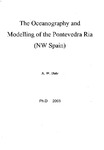The Oceanography and Modelling of the Pontevedra Ria (NW Spain)
| dc.contributor.author | Dale, Andrew W. | |
| dc.contributor.other | Faculty of Science and Engineering | en_US |
| dc.date.accessioned | 2013-10-02T12:20:24Z | |
| dc.date.available | 2013-10-02T12:20:24Z | |
| dc.date.issued | 2003 | |
| dc.identifier | NOT AVAILABLE | en_US |
| dc.identifier.uri | http://hdl.handle.net/10026.1/1966 | |
| dc.description.abstract |
A multidisciplinary study the oceanography of the Pontevedra Ria (NW Spain), including hydrography, biogeochemistiy and biogeochemical modelling, has been performed. The hydrographical variability of the Pontevedra Ria was dependent on freshwater inputs and upwelling of nutrient-rich East North Atlantic Central Water from the shelf. Intrusions of the Poleward Current were also detected during winter. A stratified box model approach predicted that upwelling water fluxes into the ria of 2-4x10³ m³ s-1, of which >30% rises to the surface waters inside the ria. Freshwater residence time varied from ~4-9 d in the central ria and 1-4 d in the internal ria. Nutrients concentrations showed a strong fluvial and oceanic signal, with a clear zone of near-bed aerobic remineralisation in the internal ria. Nutrient flux experiments showed that high nutrient fluxes, particularly ammonium (3.5 mg N mˉ² hˉ¹), coincided with period of high water influx to the ria. These were related to stirring of quasi-benthic phytodetrital fluff. Denitrification was a major fate for particulate organic nitrogen in the sediment, averaging 2.5 mg N m ˉ² h ˉ¹ for the spring and dry season. A non-steady state nutrient budget revealed that the central and internal zones of the Pontevedra Ria display different biogeochemical characteristics. Net community production (NCP) based on phosphate uptake was spatially and temporally variable, with rates of 9.6 and 20.2 mg C m ˉ² h ˉ¹ in central and internal rias in spring, respectively, and 30.3 and 29.0 mg C m ˉ² h ˉ¹ in the dry season. Previously unquantified benthic nutrient inputs were important, and up to 25% of NCP was due to the sediment nutrient flux in the dry season. Denitrification calculated with the nutrient budget equalled 1.82 and 5.66 mg N m ˉ² h ˉ¹ in the dry season in the central and internal ria, respectively, and was equal to 27 and 42% of dry season NCP. The robustness of the box model was questioned, and found to be an unsuitable modelling approach for the Rias Bajas. This had clear implications for predicting NCP and net nutrient budgets to the coastal zone. Salinity and temperature were simulated with the commercially-available simulation shell, ECoS, to within the analytical error of the observed data. Inorganic nutrient concentrations and benthic effluxes were qualitatively and quantitatively agreeable with observed data. Phytoplankton growth in ECoS was limited by up to 30% by phosphorus rather than nitrogen, as previously believed. The annual evolution of NCP was successfully reproduced by examining the chlorophyll-normalised rate of organic carbon production. Mean NCP In the spring and dry season was 46.5 and 147 mg c m ˉ² h ˉ¹, which agreed well with the literature. There were clear discrepancies between box model and ECoS-derived nutrient export to the Atlantic ocean. The definitions of constituent uptake and remineralisation processes between the two approaches were examined In the context of biogeochemical modelling and environmental management of the Rias Bajas. | en_US |
| dc.language.iso | en | en_US |
| dc.publisher | University of Plymouth | en_US |
| dc.title | The Oceanography and Modelling of the Pontevedra Ria (NW Spain) | en_US |
| dc.type | Thesis | |
| plymouth.version | Full version | en_US |
| dc.identifier.doi | http://dx.doi.org/10.24382/4829 |
Files in this item
This item appears in the following Collection(s)
-
01 Research Theses Main Collection
Research Theses Main


